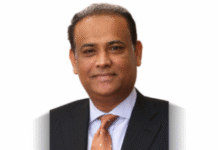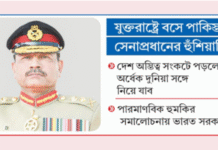Will DUCSU usher in non-political rise of youth?
 Back in the seventies, Maulana Bhasani boycotted the election, with a fiery slogan to kick out the ballot boxes and free Bangladesh. Not one literally kicked out the ballot boxes. In fact, Awami League and many political parties in independent Bangladesh have boycotted the elections several times, but no one actually kicked out any ballot boxes.
Back in the seventies, Maulana Bhasani boycotted the election, with a fiery slogan to kick out the ballot boxes and free Bangladesh. Not one literally kicked out the ballot boxes. In fact, Awami League and many political parties in independent Bangladesh have boycotted the elections several times, but no one actually kicked out any ballot boxes.
But that did happen in this DUCSU election. The students of Ruqayyah Hall actually did so in protest of the irregularities in the election. Other than the university administration, the government and the ruling party’s student front, almost everyone termed this election as a sheer farce. Even the predecessor of the present vice chancellor, and the teachers observing the election expressed shame and dismay.
On the day after the Dhaka University Central Students Union (DUCSU) election, that is 12 February, the Daily Star carried a caricature of two faces in one – half depicting the Dhaka University VC Mohammad Akhtaruzzaman and the other half chief election commissioner Mohammad Nurul Huda. The cartoon indicated how these two characters had dragged elections down to an all-time low. They both aided and abetted the ruling coterie in rigging the elections, why spewing out rhetoric to deny ground reality.
Minor irregularities and errors are nothing new in Bangladesh’s elections. But the irregularities and manipulations in the DUCSU election can only be compared to the national election held under the political government. Chhatra League enjoyed the same facilities and in the DUCSU polls as did Awami League and its allies in the national election. In some cases they had even more perks, such a non-transparent ballot boxes, no seals or stamps on the ballot papers to verify they were genuine, polling centres controlled by Chhatra League leaders set up in the halls, not allowing polling agents to be present, and so on.
If the ballot box stuffed the previous night hadn’t been discovered at Kuwait Maitree Hall, then undoubtedly this controlled election model would be a success. Attempts were made to portray the recovery of the three ballot boxes at Ruqayyah Hall to be an effort by anti-government elements to snatch away the ballots and a case was even filed in his regard.
In Shamsunnahar Hall, the girls guarded the polling room the entire night. The panel of the general students’ rights council and won the election there, pointing to what the results are when the votes are not rigged. These students are not any different from the other students of the university. They anger and frustration is no different that the male students. The quality of the food at their hall, the furniture, the library facilities, the recreational equipment in the common room and the standard of living is not worse than that of the boys. They do not suffer more than the boys.
The fact is that the girl students managed to vote more or less freely and according to their own choice. This was not possible in the boys’ halls. Chhatra League was in control in the boys’ hall. Live telecast by Yamuna TV showed the Chhatra Dale candidates with the same complaint to the provost of AF Raman Hall. He had no befitting reply.
It has already been reported how certain strategies were adopted to slow down the voters’ line. It is a logical deduction, then, the trend of the voters would go in the same direction as that in the girls’ halls, had the voting been free and fair.
The question may arise, if the students had so much anger against the government, then why didn’t the candidates of the opposition ilk fare well in the election. And why are the common students apparently more inclined towards the non-political students who had been in the movement? After all, this university has a tradition of political struggle and movements. With Awami League and BNP being the two major political opponents, it would be assumed that their front organizations would also be equal rivals. But it is not so in DUCSU. And it is surely not just because of their long absence from the campus.
The left student parties had been fairly active on campus, but they too lagged behind in the election. But the common students had long been irate due to the ‘guest room’ sufferings, the rule of the pro-government elements in the halls, and violence used to stifle any different views.
In such unnatural circumstances, new leaderships are emerging on the scene from among the non-political students, and without any political patronage. They clearly are the actual representatives of the students.
This rise of non-political elements among the youth is significant. Youth make up the largest demographic dividend. There is a disconnect between the current trend of politics and the youth. What is the political vision of these young people? How can it be fulfilled. Is the depoliticisation the part of an organised process? Authoritarians benefit from such depolitisation. This is risky too.
The quota reform movement, the safe roads movement and the demand to increase the age limit for appointment to public service indicate the aspirations of the youth.
The crash of 2008 which resulted from an aggressive profit-hungry capitalist system, had had an impact over the past decade. Occupy Wall Street and 99 per cent were spontaneous movements centering on the financial markets.
Schools children in the US protested spontaneously, calling for gun control. This protest made waves in mainstream politics. School children also protested against climate change.
The rebellious voice of youth may not have direct link with global trends, but they have similarity in thoughts and action.
* This piece appeared in Prothom Alo print edition and has been rewritten here in English by Ayesha Kabir









